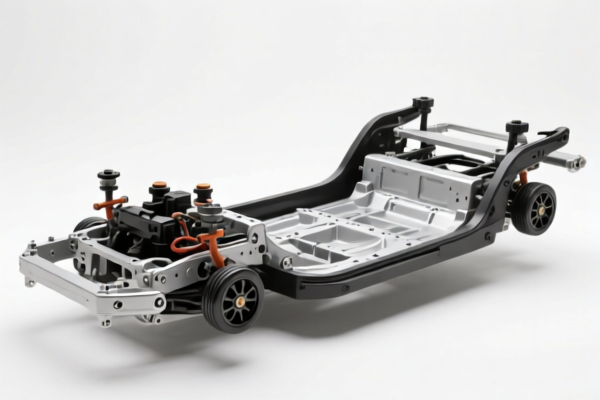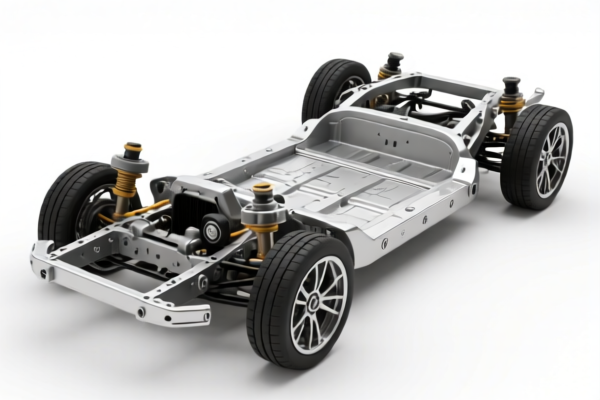Found 4 matching results
(CN → US)
| HS Code | Official Doc | Tariff Rate | Origin | Destination | Effective Date |
|---|---|---|---|---|---|
| 8706000300 | Doc | 59.0% | CN | US | 2025-05-12 |
| 7308903000 | Doc | 80.0% | CN | US | 2025-05-12 |
| 7308906000 | Doc | 80.0% | CN | US | 2025-05-12 |
| 7326908688 | Doc | 82.9% | CN | US | 2025-05-12 |




Chassis
A chassis is the structural frame of a vehicle which supports the engine, drivetrain, axles, wheels and body. It is a fundamental component of automobiles, motorcycles, bicycles, and other wheeled vehicles. Beyond vehicles, the term can refer to the supporting frame of machinery or electronic equipment.
Materials
Chassis construction utilizes a variety of materials, evolving with technological advancements and performance requirements:
- Steel: Historically the predominant material, offering high strength and relatively low cost. Various steel alloys are employed, including high-strength low alloy (HSLA) steel.
- Aluminum: Increasingly common, particularly in high-performance vehicles, due to its lighter weight, improving fuel efficiency and handling. Often used in conjunction with steel for optimal strength-to-weight ratios.
- Carbon Fiber: Employed in racing and high-end vehicles, offering exceptional strength and stiffness with minimal weight. Expensive and complex to manufacture.
- Composite Materials: Combinations of materials like carbon fiber, fiberglass, and resins are used to tailor chassis properties.
- Wood: Historically used, particularly in early automobiles and bicycles; now largely limited to vintage restorations or specialized applications.
Purpose & Function
The primary functions of a chassis are:
- Structural Support: Provides a rigid framework to which all other vehicle components are attached.
- Load Bearing: Supports the weight of the vehicle, passengers, and cargo.
- Impact Absorption: Designed to absorb and distribute impact forces in the event of a collision.
- Handling & Stability: Influences the vehicle's handling characteristics and stability.
- Drivetrain Support: Provides mounting points for the engine, transmission, driveshaft, and axles.
Usage Scenarios
Chassis designs vary significantly based on the intended application:
- Passenger Vehicles: Focus on comfort, safety, and handling. Typically utilize a unibody or body-on-frame construction.
- Commercial Vehicles (Trucks, Buses): Emphasize load capacity and durability. Commonly employ a ladder frame construction.
- Racing Vehicles: Prioritize lightweight construction, rigidity, and aerodynamic efficiency. Often utilize space frame or monocoque designs.
- Motorcycles: Chassis designs vary widely depending on the type of motorcycle (sportbike, cruiser, touring, etc.), balancing handling, comfort, and weight.
- Bicycles: Chassis, or frames, are designed for lightweight, strength and efficient power transfer. Materials range from steel and aluminum to carbon fiber and titanium.
- Machinery & Electronics: Provides a stable platform for mounting components and protecting them from damage.
Common Types
- Ladder Frame: A traditional design consisting of two longitudinal rails connected by crossmembers. Simple, robust, and suitable for heavy-duty applications.
- Unibody (Monocoque): The body and chassis are integrated into a single structure. Lighter and stiffer than body-on-frame designs, offering improved handling and safety.
- Space Frame: A complex structure composed of interconnected tubes. Offers exceptional strength-to-weight ratio, commonly used in racing vehicles.
- Backbone Chassis: A single central tube or beam that supports the majority of the vehicle's weight. Commonly found in motorcycles.
- Tubular Chassis: Similar to a space frame, but often simpler in construction. Frequently used in off-road vehicles and kit cars.
- Semi-Monocoque: A hybrid design combining elements of both monocoque and ladder frame construction.
Chassis Classification and Tariff Information
Chassis, based on the provided information, fall under the following classifications:
- 8706000300: This HS code covers chassis fitted with engines, specifically for motor vehicles of headings 8701 to 8705. It is further defined for vehicles of subheading 8701.21, 8701.22, 8701.23, 8701.24 or 8701.29 or heading 8702 or 8704, and also for vehicles of subheading 8704.21 or 8704.31.
- 87: Chapter 87 pertains to Vehicles and their parts and accessories.
- 06: Heading 06 specifies Bodies (coachwork), chassis fitted with engines, and parts and accessories of motor vehicles.
- 000300: This further narrows down the classification to chassis fitted with engines as described above.
- Tariff Details: The base tariff is 4.0%, with an additional surcharge of 25.0%. After April 2, 2025, the surcharge increases to 30.0%, resulting in a total tariff of 59.0%.
Important Note: The total tariff for this HS code is 59.0%.
Customer Reviews
No reviews yet.